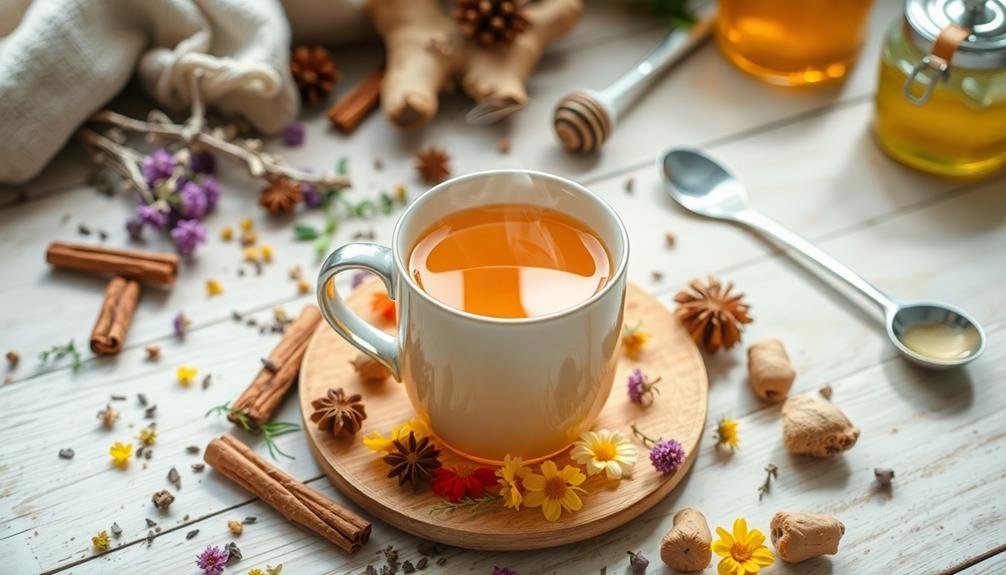To maximize the heart-boosting benefits of hawthorn berry tea, start by selecting high-quality, organic berries. Brew properly using 1-2 teaspoons per cup, steeping for 10-15 minutes. Gradually increase your intake to 2-3 cups daily, spacing them throughout the day. Combine with complementary herbs like linden or motherwort for enhanced effects. Time your consumption strategically, such as in the morning or post-exercise. Store berries in airtight containers away from light to maintain potency. Be aware of potential side effects and consult your healthcare provider if needed. Incorporate the tea into your daily routine and track your heart health progress. These tips are just the beginning of your journey to better cardiovascular health.
Choosing Quality Hawthorn Berries

Many factors influence the quality of hawthorn berries for tea. When selecting hawthorn berries, look for bright red, fully ripe berries that are firm to the touch. Avoid berries that are discolored, moldy, or have signs of insect damage. Opt for organic hawthorn berries whenever possible to guarantee they're free from pesticides and other harmful chemicals.
Consider the source of your hawthorn berries. Reputable herb suppliers or health food stores often provide high-quality, sustainably harvested berries. If you're foraging for hawthorn berries yourself, make sure you can accurately identify the plant and collect from areas free from pollution or chemical treatments.
The drying process is vital for preserving the berries' medicinal properties. Properly dried hawthorn berries should be dark red or brownish-red and slightly wrinkled. They shouldn't feel damp or sticky. If you're purchasing pre-dried berries, check the packaging date to verify freshness.
Store your hawthorn berries in an airtight container in a cool, dark place to maintain their potency. Properly stored, dried hawthorn berries can retain their beneficial properties for up to a year.
Proper Brewing Techniques
To brew the perfect cup of hawthorn berry tea, start with the right proportions. For every 8 ounces of water, use 1-2 teaspoons of dried hawthorn berries. If you're using fresh berries, double the amount.
Begin by bringing water to a boil in a pot or kettle. Once boiling, remove the water from heat and add the hawthorn berries. Cover the pot and let the berries steep for 10-15 minutes. The longer you steep, the stronger the flavor and potential health benefits.
After steeping, strain the tea into your cup using a fine mesh strainer or cheesecloth. For a stronger brew, you can gently crush the berries before steeping to release more of their beneficial compounds.
If you find the taste too tart, add a touch of honey or stevia for sweetness. You can also enhance the flavor by adding complementary herbs like cinnamon, ginger, or lemon balm.
Remember to let the tea cool slightly before drinking to avoid burning your mouth. You can enjoy hawthorn berry tea hot or cold, but don't reheat it as this may diminish its beneficial properties.
Recommended Daily Intake

Health experts generally recommend consuming 1-3 cups of hawthorn berry tea daily for ideal heart-health benefits. However, it's essential to start with a lower dose and gradually increase it to assess your tolerance.
Remember that individual needs may vary based on factors like age, weight, and overall health condition.
When incorporating hawthorn berry tea into your daily routine, consider the following guidelines:
- Start with one cup per day for the first week
- Increase to two cups daily in the second week, if well-tolerated
- Aim for a maximum of three cups per day after the third week
- Space out your consumption throughout the day
- Consult your healthcare provider before exceeding three cups daily
It's important to note that while hawthorn berry tea is generally safe, it may interact with certain medications, particularly those for heart conditions.
Always inform your doctor about your herbal tea consumption, especially if you're taking prescription drugs. If you experience any adverse effects, such as dizziness, nausea, or rapid heartbeat, discontinue use and seek medical advice promptly.
Combining With Complementary Herbs
You can enhance your hawthorn berry tea experience by combining it with complementary herbs.
Try pairing hawthorn with lemon balm or hibiscus for added flavor and potential heart health benefits.
These synergistic combinations may amplify the cardioprotective effects of hawthorn while creating a more enjoyable beverage.
Synergistic Herb Pairings
Frequently, combining hawthorn berry tea with complementary herbs can enhance its heart-boosting benefits. By pairing hawthorn with synergistic herbs, you'll create a powerful blend that supports cardiovascular health.
Consider these herb combinations to maximize the potential of your hawthorn berry tea:
- Linden: This herb complements hawthorn's ability to improve blood flow and reduce blood pressure.
- Motherwort: Known for its calming effects, it works well with hawthorn to reduce anxiety and support heart rhythm.
- Ginger: Its anti-inflammatory properties pair nicely with hawthorn's antioxidant effects, promoting overall heart health.
- Hibiscus: Rich in vitamin C, it enhances hawthorn's ability to strengthen blood vessels and lower blood pressure.
- Rosehips: High in vitamin C, they boost hawthorn's antioxidant properties and support immune function.
When creating these blends, start with a 2:1 ratio of hawthorn to the complementary herb. Adjust the proportions based on your taste preferences and how your body responds.
Remember to consult with a healthcare professional before incorporating new herbal combinations, especially if you're taking medications or have existing health conditions.
Flavor Enhancement Options
While hawthorn berry tea offers numerous health benefits, its taste can be quite bland or bitter for some. To enhance its flavor and make it more enjoyable, you can combine hawthorn with complementary herbs and ingredients. These additions not only improve the taste but can also boost the tea's overall health benefits.
Consider experimenting with these flavor-enhancing options:
| Herb/Ingredient | Flavor Profile |
|---|---|
| Cinnamon | Warm, spicy |
| Lemon | Citrusy, tangy |
| Ginger | Spicy, zesty |
| Honey | Sweet, smooth |
| Mint | Cool, fresh |
You'll find that adding a stick of cinnamon or a slice of lemon can transform your hawthorn tea into a more palatable beverage. If you're looking for a spicier kick, try grating some fresh ginger into your brew. For those with a sweet tooth, a drizzle of honey can counteract the bitterness while providing additional health benefits. Finally, a few fresh mint leaves can add a revitalizing twist to your tea, making it perfect for hot summer days.
Amplifying Heart Health Benefits
Herbal synergy can greatly boost the heart-healthy properties of hawthorn berry tea. By combining hawthorn with other cardiovascular-supporting herbs, you'll enhance its overall benefits and create a more potent heart tonic.
Consider adding these complementary herbs to your hawthorn brew:
- Hibiscus: Rich in antioxidants, it supports healthy blood pressure levels
- Linden: Promotes relaxation and may help lower blood pressure
- Motherwort: Traditionally used to calm heart palpitations and reduce anxiety
- Ginger: Improves circulation and has anti-inflammatory properties
- Garlic: Supports overall cardiovascular health and blood flow
When blending these herbs with hawthorn, start with small amounts and adjust to your taste preferences. You can create custom tea blends or use pre-made heart health tea formulas that include hawthorn and its complementary herbs.
Remember to steep your tea for at least 10-15 minutes to extract the maximum beneficial compounds. If you're taking medications or have existing heart conditions, consult your healthcare provider before incorporating new herbal combinations into your routine.
Timing Your Tea Consumption

When it comes to enjoying hawthorn berry tea for heart health, timing matters.
You'll want to contemplate the best times of day to drink your tea, how often you should consume it, and the appropriate dosage for maximum benefits.
Understanding these factors can help you optimize the heart-boosting effects of hawthorn berry tea in your daily routine.
Best Times to Drink
Timing your hawthorn berry tea consumption can maximize its potential heart benefits. While you can enjoy this heart-healthy brew throughout the day, certain times may be more beneficial. Consider incorporating hawthorn berry tea into your daily routine at these ideal moments:
- First thing in the morning: Kickstart your cardiovascular system
- Before meals: Aid digestion and promote better nutrient absorption
- Mid-afternoon: Combat fatigue and support heart health during the day
- After exercise: Help your heart recover from physical exertion
- Before bed: Promote relaxation and support nighttime heart function
You'll want to avoid drinking hawthorn berry tea too close to bedtime if you're sensitive to caffeine, as it contains small amounts.
It's also best to space out your tea consumption, allowing at least 2-3 hours between cups. This guarantees your body can fully absorb the beneficial compounds without overwhelming your system.
If you're taking medications, especially for heart conditions, consult your healthcare provider about the best times to drink hawthorn berry tea. They may recommend adjusting your tea consumption schedule to avoid potential interactions with your medications and enhance the tea's heart-boosting effects.
Frequency and Dosage Recommendations
Three key factors determine the ideal frequency and dosage of hawthorn berry tea: your health goals, individual tolerance, and any existing medical conditions. Generally, it's safe to consume 1-2 cups daily, but always consult your healthcare provider before starting a new regimen.
For cardiovascular support, you might drink hawthorn berry tea 2-3 times a day. If you're using it for mild anxiety or sleep support, a single cup before bedtime may suffice. Start with a lower dosage and gradually increase it to assess your body's response.
Here's a guide to help you determine your best intake:
| Health Goal | Recommended Frequency | Dosage per Cup |
|---|---|---|
| Heart Health | 2-3 times daily | 1-2 tsp dried berries |
| Blood Pressure | 1-2 times daily | 1-1.5 tsp dried berries |
| Anxiety Relief | Once daily (evening) | 1 tsp dried berries |
| Sleep Support | Once daily (bedtime) | 1-1.5 tsp dried berries |
| General Wellness | 1-2 times daily | 1 tsp dried berries |
Enhancing Flavor Naturally
Spicing up your hawthorn berry tea can take its flavor profile to the next level while maintaining its health benefits. You'll find that natural additions can complement the slightly tart taste of hawthorn berries, making your tea more enjoyable.
Consider these flavor-enhancing options:
- Honey or stevia for natural sweetness
- Cinnamon sticks for warmth and spice
- Fresh lemon or orange slices for a citrusy kick
- Ginger root for a zesty, warming effect
- Mint leaves for a cool, revitalizing twist
When enhancing your tea's flavor, it's important to choose ingredients that won't interfere with hawthorn's heart-healthy properties. Start with small amounts and adjust to your taste preferences.
You can experiment with different combinations to find your perfect blend. For example, try pairing honey with cinnamon for a comforting, sweet-spicy mix, or combine lemon and ginger for a zesty, invigorating drink.
Remember that these natural additions can also contribute their own health benefits, potentially boosting the overall nutritional value of your hawthorn berry tea. By thoughtfully enhancing the flavor, you're more likely to enjoy this beneficial beverage regularly, supporting your heart health in a delicious way.
Storing for Maximum Potency

Now that you've perfected your hawthorn berry tea's flavor, it's important to focus on proper storage to maintain its potency.
Store your dried hawthorn berries in an airtight container, away from direct sunlight and heat sources. A cool, dark pantry or cupboard is ideal. Make sure the storage area has low humidity to prevent mold growth.
If you've purchased pre-packaged tea bags, keep them in their original packaging until use. For loose berries, transfer them to a glass jar with a tight-fitting lid. Avoid using plastic containers, as they can absorb odors and affect the tea's taste.
Label your container with the date of purchase or harvest to track freshness. Properly stored, dried hawthorn berries can maintain their potency for up to a year. However, for best benefits, try to use them within six months.
If you've brewed a large batch of tea, store it in the refrigerator for up to 48 hours. Avoid keeping it at room temperature for extended periods, as this can lead to bacterial growth and loss of potency.
When reheating, do so gently to preserve the tea's beneficial compounds.
Understanding Potential Side Effects
Safety should be your top priority when incorporating hawthorn berry tea into your routine. While generally considered safe, hawthorn berry can cause side effects in some individuals.
It's essential to be aware of potential reactions and consult your healthcare provider before use, especially if you're taking medications or have pre-existing conditions.
Common side effects may include:
- Mild nausea or upset stomach
- Headache or dizziness
- Fatigue or weakness
- Palpitations or changes in heart rate
- Skin rashes or itching
If you experience any of these symptoms, discontinue use and seek medical advice.
Hawthorn berry can interact with certain medications, particularly those for heart conditions, blood pressure, and blood thinners. It may also affect blood sugar levels, so diabetics should monitor their glucose closely.
Pregnant or breastfeeding women should avoid hawthorn berry tea due to insufficient safety data.
Additionally, if you're scheduled for surgery, stop consuming hawthorn berry at least two weeks prior, as it can interfere with anesthesia and blood pressure control during the procedure.
Incorporating Into Your Routine

To maximize the benefits of hawthorn berry tea, consider when and how you consume it.
You'll find the best times to drink this heart-healthy brew are typically in the morning or early afternoon, as it may interfere with sleep if consumed too late.
For added variety and potential synergistic effects, try pairing hawthorn berry tea with other herbal teas like hibiscus or green tea.
Best Times to Drink
Incorporating hawthorn berry tea into your daily routine can enhance its heart-boosting benefits. The best times to drink this heart-healthy beverage depend on your lifestyle and specific health goals. Consider these ideal moments to enjoy your hawthorn berry tea:
- First thing in the morning: Kickstart your day with a cup to support circulation and energy levels.
- Before meals: Drinking tea 15-30 minutes before eating may aid digestion and nutrient absorption.
- Mid-afternoon: Combat the post-lunch slump with a revitalizing cup to maintain focus and energy.
- After exercise: Replenish fluids and support cardiovascular recovery following physical activity.
- Before bedtime: Enjoy a caffeine-free cup to promote relaxation and better sleep quality.
Remember to space out your tea consumption throughout the day for consistent benefits.
If you're taking medications, consult your healthcare provider about potential interactions and ideal timing.
You might find it helpful to set reminders or integrate tea breaks into your daily schedule.
Pairing With Other Teas
Blending hawthorn berry tea with other herbal infusions can enhance its flavor and health benefits. You'll find that combining it with hibiscus tea creates a tangy, heart-healthy blend rich in antioxidants.
For a calming effect, mix hawthorn with chamomile or lemon balm. This combination can help reduce stress while supporting cardiovascular health.
If you're looking to boost your immune system, pair hawthorn berry tea with elderberry or echinacea. These herbs work synergistically to strengthen your body's defenses.
For a digestive aid, try blending hawthorn with peppermint or ginger. This combination can help soothe your stomach while promoting heart health.
To create a more robust flavor profile, consider mixing hawthorn with cinnamon or rose hips. These pairings not only taste great but also provide additional vitamin C and antioxidants.
For a caffeine-free energy boost, combine hawthorn with green rooibos or nettle leaf. This blend can help improve circulation and overall liveliness.
Remember to experiment with different ratios to find your perfect blend. Start with equal parts of each tea and adjust according to your taste preferences.
Always consult your healthcare provider before incorporating new herbal teas into your routine, especially if you're taking medications.
Tracking Heart Health Progress
Progress is key when it comes to improving your heart health with hawthorn berry tea. To guarantee you're reaping the benefits, it's crucial to track your progress regularly. Start by establishing a baseline for your heart health metrics before beginning your hawthorn berry tea regimen. This will help you measure improvements over time.
Keep a detailed log of your daily tea consumption, including the amount and time of day you drink it. Monitor your blood pressure, cholesterol levels, and heart rate regularly, and record these measurements in your log.
You'll want to track any changes in your overall energy levels, sleep quality, and exercise tolerance as well.
Here are some additional ways to track your heart health progress:
- Use a smartwatch or fitness tracker to monitor your daily activity and heart rate
- Schedule regular check-ups with your healthcare provider
- Keep a food diary to track your overall diet alongside your tea consumption
- Note any changes in medications or supplements you're taking
- Record any symptoms or side effects you experience
Frequently Asked Questions
Can Hawthorn Berry Tea Interact With Heart Medications?
Yes, hawthorn berry tea can interact with heart medications. You should always consult your doctor before combining them. It may affect blood pressure and heart rhythm, potentially enhancing or interfering with your prescribed medications' effects.
How Long Does It Take to See Benefits From Drinking Hawthorn Berry Tea?
You'll typically see benefits from hawthorn berry tea within 3-6 weeks of regular consumption. However, it's crucial to acknowledge that results can vary. Be patient and consistent, and consult your doctor for personalized advice.
Is Hawthorn Berry Tea Safe for Pregnant or Breastfeeding Women?
You shouldn't drink hawthorn berry tea if you're pregnant or breastfeeding. There's not enough research on its safety for these groups. It's best to consult your healthcare provider before using any herbal remedies during these times.
Can Children Drink Hawthorn Berry Tea for Heart Health?
You shouldn't give hawthorn berry tea to children for heart health. It's not recommended for kids due to potential side effects and lack of research. Always consult a pediatrician before introducing any herbal remedies to a child's diet.
Are There Any Alternatives to Hawthorn Berry Tea for Similar Heart Benefits?
You've got options! Try hibiscus tea, green tea, or garlic tea for heart benefits. CoQ10 supplements and omega-3 fatty acids are great alternatives too. Don't forget regular exercise and a balanced diet for ideal heart health.
In Summary
You've now got the tools to make hawthorn berry tea a powerful ally for your heart health. Remember to choose quality berries, brew properly, and consume wisely. Don't forget to combine with complementary herbs and time your intake for maximum benefits. Keep an eye on potential side effects and store your tea correctly. By incorporating hawthorn tea into your routine and tracking your progress, you'll be well on your way to a healthier heart.





Leave a Reply